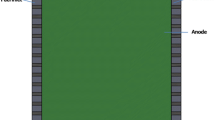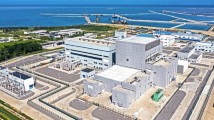Abstract
A two-dimensional model is developed to describe the hydrodynamics, heat transfer and adsorption phenomena associated with the adsorptive storage of natural gas (NG) in cylindrical reservoirs. Intraparticle and film resistances to both heat and mass transfer are neglected. In the momentum equation, Ergun's law is considered locally valid and is extended to two dimensions. These assumptions are fully justified in the paper. Numerical results are presented concerning the pressurization and blowdown of an ultra-lightweight 50 litre cylinder, commercially available for the storage of compressed NG, if it were filled with an activated carbon having a good adsorptive storage capacity. A simple formula is also proposed to predict the filling times for fast charges. The predicted temperature changes in the packed-bed are in good agreement with those reported in the literature for an experimental charge/discharge.
Similar content being viewed by others
Abbreviations
- b :
-
Parameter of the Langmuir equilibrium relation (Pa−1)
- C pg :
-
Heat capacity of gas at constant pressure (J kg−1 K−1)
- C ps :
-
Heat capacity of the adsorbent (J kg−1 K−1)
- c :
-
Gas concentration (kg m−3)
- d p :
-
Particle diameter (m)
- G:
-
[=G zez+G rer=cv] Mass superficial velocity vector (kg m−2 s−1)
- G m :
-
mass flow (kg m−2 s−1)
- H :
-
Enthalpy of the gas (J kg−1)
- ΔH :
-
Isosteric heat of adsorption (J kg−1)
- h w :
-
Effective heat transfer coefficient at the wall (J m−1 s−1)
- L :
-
Length of the cylinder (m)
- M g :
-
Molecular mass of the gas (kg mol−1)
- P :
-
Pressure (Pa)
- Pe z :
-
[=G zCpgL/λe] Axial Peclet number
- Q :
-
Energy flux (J m−2 s−1)
- q :
-
Concentration of the adsorbed phase (kg kg−1)
- q m :
-
Saturation limit of the Langmuir equilibrium relation (kg kg−1)
- R :
-
Ideal gas constant (=8.31441 J mol−1 K−1)
- R i :
-
Radius of the tank opening (m)
- R 0 :
-
Cylinder radius (m)
- r :
-
Radial coordinate (m)
- T :
-
Temperature (K)
- T w :
-
Wall temperature (K)
- t :
-
Time (s)
- v:
-
[=υzez+υrer] Superficial velocity (m s−1)
- z :
-
Axia coordinate (m)
- γ :
-
Constant
- ε :
-
Bed (interparticle) porosity
- ε p :
-
Adsorbent (intraparticle) porosity
- ε t :
-
[=ε+(1−ε)ε p] Total porosity
- λe :
-
Effective thermal conductivity tensor (J K−1 m−1 s−1)
- λ 0e :
-
Static contribution of the effective thermal conductivity tensor (J K−1 m−1 s−1)
- λer :
-
radial component of the effective thermal conductivity tensor (J K−1 m−1 s−1)
- λez :
-
axial component of the effective thermal conductivity tensor (J K−1 m−1 s−1)
- λg :
-
Thermal conductivity of the gas (J K−1 m−1 s−1)
- λs :
-
Thermal conductivity of the solid (J K−1 m−1 s−1)
- μ :
-
Viscosity of the gas (kg m−1 s−1)
- ρ b :
-
[=(1−ε)(1−ε p)ρ s] Packing (bed) density (kg m−3)
- ρ s :
-
Density of the solid (kg m−3)
- −:
-
Average value
- ∼:
-
Reference conditions
- ′:
-
Partial derivative with respect to time
- end:
-
Conditions at the end of the charge/discharge
- ext:
-
External gas
- i :
-
Initial conditions
References
Brenan, K.E., S.L. Campbell, and L.R. Petzold,Numerical Solution of Initial-Value Problems in Differential-Algebraic Equations, Elsevier Science Publishing Co., Inc., New York, 1989.
Brinkman, H.C., “A calculation of the viseous force extended by a flowing fluid on a dense swarm of particles,”Appl. Scient. Res.,A1, 27–34 (1947).
Ergun, S., “Fluid flow through packed columns,”Chem. Eng. Prog.,42, 89 (1952).
Gear, C.W., “The simultaneous numerical solution of differential-algebraic equations,”IEEE Trans. Circuit Theory,CT-18, 89–95 (1971).
Lu, Z.P., J.M. Loureiro, M.D. LeVan, and A.E. Rodrigues, “Dynamics of pressurization and blowdown of an adiabatic bed: III,”Gas Sep. & Purif.,6, 15–23 (1992).
Matranga, K.R., A.L. Myers, and E.D. Glandt, “Storage of natural gas by adsorption on activated carbon,”Chem. Eng. Sci.,47, 1569–1579 (1992).
Parsons, I.M. and K.E. Porter, “Gas flow patterns in packed beds: A computational fluid dynamics model for wholly packed domains,”Gas Sep. & Purif.,6, 221–227 (1992).
Patankar, S.V.,Numerical Heat Transfer and Fluid Flow, Hemisphere Publishing Corp., New York, 1980.
Petzold, L.R., “A Description of DASSL: A differential/algebraic system solver,”Scientific Computing, R.S. Stepleman et al. (Eds.), North-Holland, Amsterdam, 65–68, 1983.
Quinn, D.,Carbon adsorbents for natural gas, Presentation to GURF meeting, London, 1990.
Raithby, G.D., “Skew upstream differencing schemes for problems involving fluid flow,”Comput. Methods Appl. Mech. Eng.,9, 153–164 (1976).
Remick, R.J. and A.J. Tiller, “Advanced methods for low-pressure storage of CNG,”The Proceedings of Nonpetroleum Vehicular Fuels Symposium, pp. 105–119, Chicago, IL, 1985.
Remick, R.J. and A.J. Tiller, “Heat generation in natural gas adsorption systems,” inThe Proceedings of the Gaseous Fuels for Transportation International Conference, Vancouver, Canada, 1986.
Schneider, G.E. and M. Zedan, “A Modified strongly implicit procedure for the numerical solution of field problems,”Numer. Heat Transfer,4, 1–19 (1981).
Sereno, C. and A.E. Rodrigues, “Can steady-state momentum equations be used in modelling pressurization of adsorption beds?”Gas Sep. & Purif.,7, 167–174 (1993).
Schiesser, W.E.,The numerical method of lines: integration of partial differential equations, Academic Press Inc., San Diego, CA, 1991.
Talu, O., “An overview of adsorptive storage of natural gas,” inThe Proceedings of the 4th International Conference on Fundamentals of Adsorption, Kyoto, Japan, 1992.
Zehner, P. and E.U. Schlunder,Chem. Eng. Techn.,44, 1303 (1970);Chem. Eng. Techn.,42, 333 (1972).
Author information
Authors and Affiliations
Rights and permissions
About this article
Cite this article
Barbosa Mota, J.P., Saatdjian, E., Tondeur, D. et al. A simulation model of a high-capacity methane adsorptive storage system. Adsorption 1, 17–27 (1995). https://doi.org/10.1007/BF00704143
Received:
Revised:
Accepted:
Issue Date:
DOI: https://doi.org/10.1007/BF00704143




